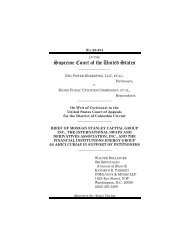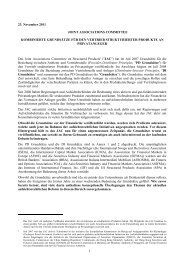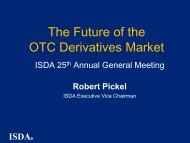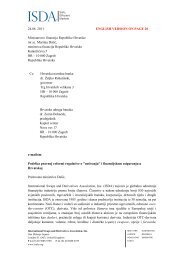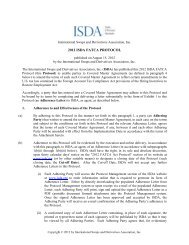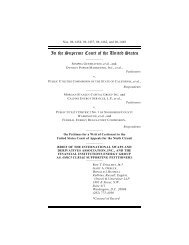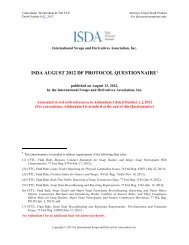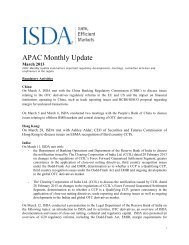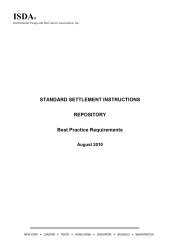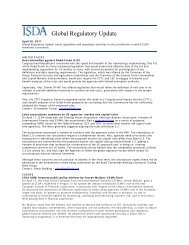ISDA Margin Survey 2013
ISDA Margin Survey 2013
ISDA Margin Survey 2013
You also want an ePaper? Increase the reach of your titles
YUMPU automatically turns print PDFs into web optimized ePapers that Google loves.
1. INTRODUCTION<br />
3<br />
<strong>ISDA</strong>’s annual <strong>Margin</strong> <strong>Survey</strong>, first published in 2000, provides information about the use of collateral in the OTC<br />
derivatives business. The data used in the <strong>2013</strong> <strong>Margin</strong> <strong>Survey</strong> is sampled as of December 31, 2012. Over the<br />
past 13 years, the <strong>Margin</strong> <strong>Survey</strong> has provided a consistent set of benchmarks for collateral use. Each year the<br />
<strong>Margin</strong> <strong>Survey</strong> evolves slightly to reflect market developments, and thus in the <strong>2013</strong> <strong>Survey</strong> more attention is<br />
paid to collateralization of cleared derivatives, in addition to coverage of the bilateral, non-cleared market. The<br />
<strong>Margin</strong> <strong>Survey</strong> is part of a broader set of <strong>ISDA</strong> initiatives in the area of collateral, including documentation, best<br />
practices and practitioner guidelines. All amounts reported are in US dollars.<br />
Sapient served as consultants to this year’s <strong>Margin</strong> <strong>Survey</strong>; the consultants collected and aggregated individual<br />
responses to the <strong>Survey</strong>. All data obtained from <strong>Survey</strong> responses were kept in strict confidence. Access by<br />
<strong>ISDA</strong> and Sapient staff is strictly limited, and the data is not shared with employees of other member firms or<br />
with any other outside party.<br />
Please note that there are various proposed and final regulations implementing the Dodd-Frank Act and EMIR in<br />
regard to collateral management. The results of this survey reflect data gathered prior to the implementation of<br />
these new regulatory requirements.<br />
1.1. COLLATERAL AS A RISK MANAGEMENT TOOL<br />
Credit risk exists in the OTC derivatives market whenever a counterpart to a transaction has an obligation to<br />
make payments or deliveries in the future. As discussed in numerous <strong>ISDA</strong> publications, there are several<br />
methods of addressing the credit risk arising from a derivatives transaction, including: holding capital against the<br />
exposure, reducing credit risk through close-out netting; having another person or entity reimburse losses<br />
through financial guarantees; or by collateralizing the exposure 1 . Each of these methods has its advantages and<br />
disadvantages.<br />
The decision to use collateral to mitigate risk is one evaluated carefully by credit risk managers in each firm that<br />
is a counterparty to a derivative transaction. This discretionary, prudential management of credit risk, which<br />
may include the use of collateral, is a common feature across a wide range of products in the capital and retail<br />
financial markets, including loans, derivatives, clearance and other types of transactions.<br />
Collateralization works best in those cases where the volume of activity is sufficient to warrant bearing the<br />
operational and procedural burdens associated with the sophisticated collateral process, provided that a legally<br />
enforceable claim can be established against collateral. Therefore, there are cases where it is simply more cost<br />
efficient or legally effective to rely on other methods of credit risk mitigation. Nonetheless, collateralization<br />
remains among the most widely used methods of mitigating counterparty credit risk in the OTC derivatives<br />
market, and market participants have increased their reliance on collateralization over the years. In an evolving<br />
regulatory environment that broadly seeks to reduce the counterparty risk associated with derivatives, the<br />
continued use of bilateral collateralization has an important role to play in risk mitigation.<br />
1 <strong>ISDA</strong>’s “Market Review of OTC Derivative Bilateral Collateralization Practices” can be found on <strong>ISDA</strong>’s website at<br />
www.isda.org.<br />
<strong>ISDA</strong> <strong>Margin</strong> <strong>Survey</strong> <strong>2013</strong> June <strong>2013</strong>



